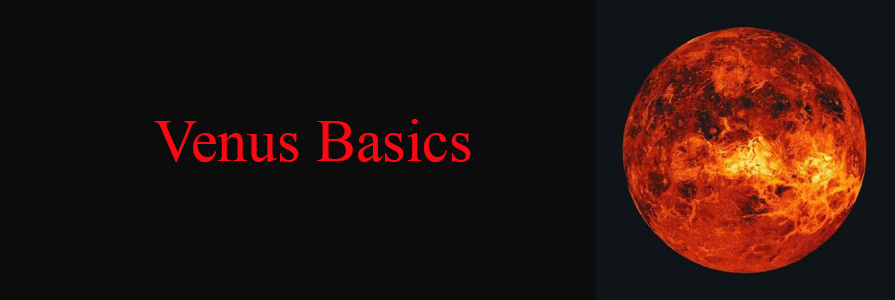
Venus Vs. Earth
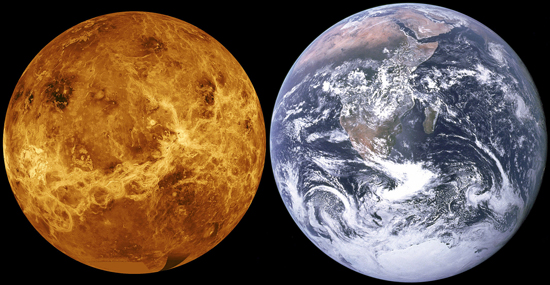
Venus and Earth are often called twins because they are similar in size, mass, density, composition and gravity. The diameter of Venus is 95% the diameter of our home planet. The diameter of Venus is 7,521 miles only 397 miles less than Earth's 7,918 miles. Venus has a mass that is 82% of Earth's. In terms of volume, the two planets are also very close, with Venus possessing 87% as much volume as Earth.
The principal difference between the two planets is the lack of evidence for any plate tectonics on Venus. This results in reduced heat loss from the planet, preventing it from cooling. Another difference, Earth’s axis is tilted far more than Venus’ is; 23.5° for Earth verses 2.6° for Venus.
Venus, the second planet from the sun, is named after the Roman goddess of love. It is the only planet named after a female. Top
The Real Color Of Venus
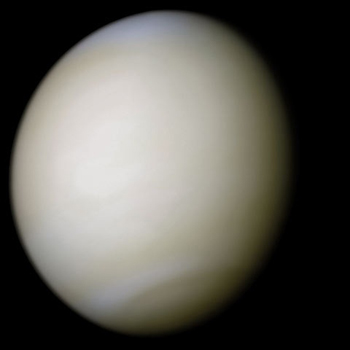
To the left is a real color image taken by Mariner 10 in 1974. This is how Venus actually looks to the eye from a distance. The Venus surface pictured above is obscured by thick sulfuric acid clouds. The thick clouds make observation of its surface impossible in visible light. The first detailed Venus maps did not emerge until the arrival of the NASA Magellan orbiter in 1991. Specialized optical equipment can penetrate the clouds to present the hard surface underneath.
As the brightest object in the sky as seen from Earth, Venus has been a major fixture in human culture for as long as records have existed. It has been sacred to gods of many cultures, and has been a prime inspiration for writers and poets as both the morning star and evening star. Venus was the first planet to have its motions plotted across the sky, as early as the second millennium BC.
As the planet with the closest distance to Earth, Venus has been a prime target for early interplanetary exploration. It was the first planet beyond Earth visited by the US spacecraft Mariner 2 in 1962. It was also the first to be successfully landed on by the Russian spacecraft Venera 7 in 1970. Top
Venus Features
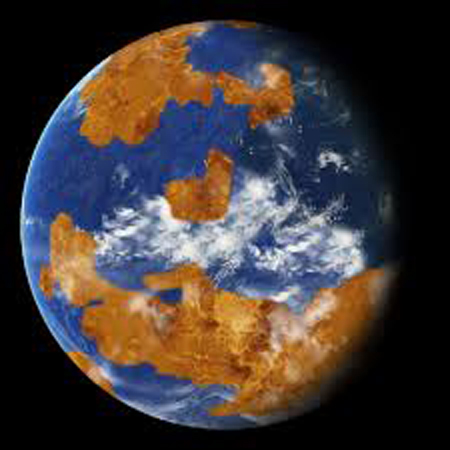
The image to the left portrays what Venus might have looked like many eons ago when it most likely had lots of water just like the Earth. The interior core of Venus is made up of a metallic iron that is roughly 2,400 miles wide. Venus' molten rocky mantle, the next section, is roughly 1,200 miles thick. Venus' top crust is mostly basalt, and is estimated to be 6 to 12 miles thick.
Roughly two-thirds of the Venus surface is covered by flat, smooth plains that are marred by thousands of volcanoes, some of which are believed to be still active today. The volcanoes range from 0.5 to 150 miles wide. Their lava flows carve long, winding canals that are up to 3,000 miles in length - longer than on any other planet.
Six mountainous regions make up about one-third of the Venusian surface. One mountain range, called Maxwell, is about 540 miles long and reaches up about 7 miles high, making it the highest feature on the planet.
Venus also possesses a number of surface features that are unlike anything on Earth. For example, Venus has coronae, or crowns - ring like structures that range from roughly 95 to 1,300 miles wide. Scientists believe these formed when hot material beneath the crust rose up, warping the planet's surface.
Venus also has tesserae, or tiles - raised areas in which many ridges and valleys have formed sprouting out in different directions. Top
The Atmosphere Of Venus
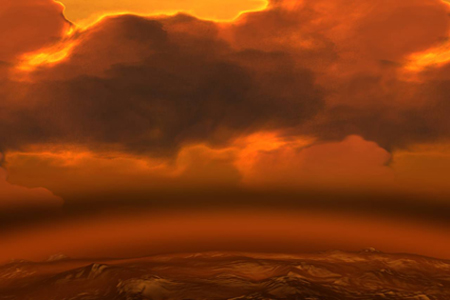
If Venus was indeed once habitable, you wouldn’t know it to look at it today. Its surface temperatures are about 870º F (470º C). Its atmosphere, almost entirely carbon dioxide (96%), has turned it into a runaway greenhouse condition. See the artists rendition of the Venus atmosphere to the left.
Yet Earth and Venus formed out of the same primordial cloud, are almost the exact same size, and are located in a similar proximity to the sun. We have liquid water and it is highly likely Venus once did too. This is a fact confirmed by American space probes which found chemical signatures of water in the Venus atmosphere.
The atmosphere is the one big difference from Earth. If you could stand on the surface of Venus, you would experience 93 times the atmospheric pressure we experience here on Earth. You would have to dive down one kilometer (0.62 miles) beneath the surface of one of our oceans to experience a similar pressure.
How Did Venus Get So Hot?
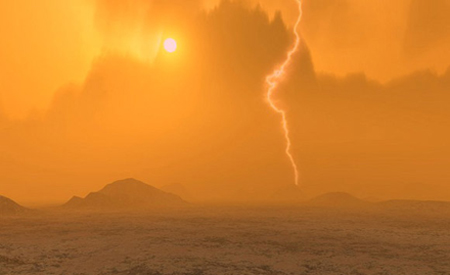
Venus has a very thick atmosphere which is about 100 times more massive than the atmosphere here on Earth. In fact, at the surface of Venus it’s hot enough to melt lead. As sunlight passes through the atmosphere, it heats up the surface of Venus. The heat becomes trapped and builds up to extremely high temperatures.
The surface temperature is the same everywhere on Venus. It does not matter if you are at the pole, or at night, it is always about 870º F. The most common theory regarding the heat is that the plate tectonics on Venus stopped moving billions of years ago. And without plate tectonics burying carbon deep inside the planet, the temperature was able to build up in the atmosphere.
The carbon dioxide on Venus increased to the point that any oceans or water of any kind just boiled away. And then the Sun’s solar wind carried the hydrogen atoms away, making it impossible to ever make liquid water again. The concentration of carbon dioxide just kept increasing until at 96%, it was just about the only gas in the atmosphere. Top
Venus Has A Very Long Day
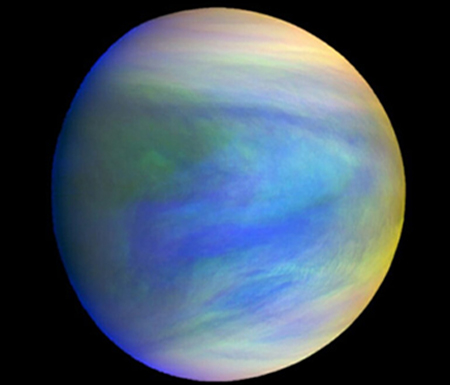
Venus has Earth beaten in a few regards. Earth displays a slight midsection bulge, being wider around its equator than it is from one pole to the other. Conversely, Venus is an almost perfect sphere. See the beautiful composite image to the left of cloud covered Venus. It was put together using data from the probe Akatsuki by the Japan Aerospace Exploration Agency.
Why is Venus almost a perfect sphere? When a massive celestial body (like a star or planet) spins quickly around its axis, centrifugal force will give it a bigger bulge around the equator. However, Venus has an ultra-slow rotation speed. It takes the equivalent of 243 Earth days for Venus to complete just one full rotation around its own axis.
However, it takes only 225 Earth days for Venus to finish one new lap around the sun. So in other words, a full day on Venus lasts longer than a Venus year does! Amazing!
Also from our Earthly perspective, Venus spins backwards. In the 1960s, scientists used radar to determine that the planet spins backward compared to its orbit, which astronomers call retrograde rotation. Most of the planets in our solar system rotate from west to east. But Uranus and Venus buck the trend. On those two worlds, the sun appears to rise in the west and set in the east. Top
Venus Probably Has Active Volcanoes
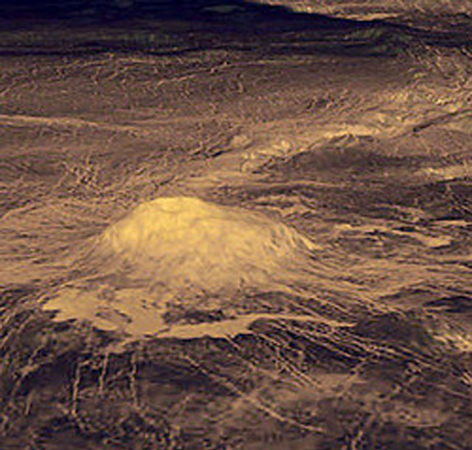
The image to the left was taken by NASA’s Magellan spacecraft using radar to see through the planet’s clouds. The volcano in the photo is Idunn Mons a large volcano with a diameter of 124 miles (200 kilometers) believed to be recently active. Venus is the planet with the most volcanoes in our solar system. Earth’s sister planet has over 1500 volcanoes and hundreds of thousands more are suspected (too small to be detected with current technology).
Researchers using data from the European Venus Express Orbiter have found compositional differences in the lava flows from three volcanoes that indicate they were active sometime in the last few hundred to 250,000 years. The fresh lavas radiate infrared or heat energy differences than the ancient flows because they are composed of different minerals.
Over time, fresh volcanic rocks weather into other rock types in Venus’ corrosive carbon dioxide atmosphere. Given its profusion of volcanic landforms, scientists suspect Venus has been active right up to the present.
Smooth volcanic rolling plains cover most of Venus' surface. Therefore something has been actively resurfacing the planet and the evidence points to volcanic lava flows plus magma upwellings from "hotspots" in the top crust. Photos show a landscape of rock composed of basalt, a common familiar volcanic rock found on Earth. Top
Venus Has Lots Of Craters
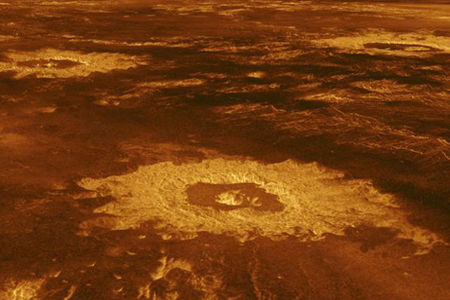
A billion years after the formation of our Solar System, there were still many types of objects flying around in it. Most of these crashed into planets and moons during the time called the "late period of heavy bombardment". Many of the craters on Mercury and our Moon were formed during this time.
However, Venus shows no record of the heavy bombardment period. Either it did not get struck, which is highly unlikely, or some process resurfaced the planet removing all traces of the impact craters. The resurfacing process stopped at some time in Venus’ more recent past. And so, all the craters that scientists do see on the surface of Venus are relatively young.
Craters on Venus are different from craters on other planets. The planet’s thick atmosphere stops smaller objects from even reaching the surface, they just burn up in the atmosphere. However, there are about 1,000 craters that have been identified on the surface of Venus.
Pictured to the left, are three craters in relatively close surroundings. Rough, but bright ejecta can be seen all around the three craters.
Top